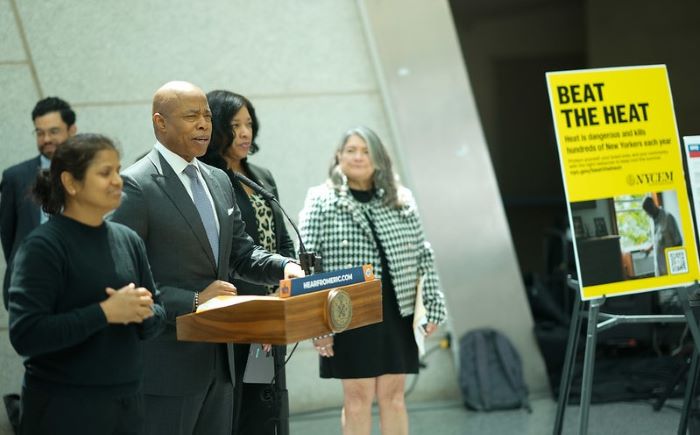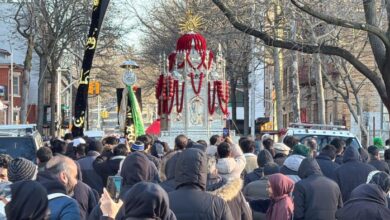NYC Summer Safety: Enjoy NYC More This Summer Thanks to Additional Lifeguards and New Cooling Centers
Mayor Eric Adams' Community Op-Ed

June 3, 2024
weekend, we unofficially kicked off the summer in New York City during Memorial Day weekend. Our beaches are open for the season, and our public pools will open June 27. New York City has so much to see and do that people forget that this is a beach town, with two of the best beaches in the entire country just a subway ride away!
We want to make sure summer in the city is fun and safe, no matter what the weather conditions. That’s why we are hitting the ground running this season, with good news about lifeguard staffing and expanded plans to protect New Yorkers from extreme heat and other emergencies.
Let’s start with lifeguards. As many New Yorkers are aware, there is a national lifeguard shortage. It’s not just an issue in the greatest city in the world. But lifeguard shortages mean fewer places to swim. That’s why the city has been working to change some of the rules in the contract with the union representing city lifeguards to allow us to hire more New Yorkers to keep more of our beaches open longer.
Last week, we announced commonsense changes that will modernize our lifeguard requirements and align them with state regulations and industry standards. It will allow us to hire more fully qualified lifeguards, keep our beaches and pools open, and improve overall safety for our swimmers, especially our children and young people
Remember: Swimming and bathing are allowed ONLY when a lifeguard is on duty. Lifeguards are on duty 7 days a week, from 10:00 AM until 6:00 PM through September 8. They are looking out for your safety, but everyone needs to do their part. Be aware of surf conditions, especially riptide warnings, which can sweep even experienced swimmers out to sea with little warning.
While a perfect day at the beach is one of the best things about summer, extreme heat can be dangerous and even deadly.
Summers are different than they used to be. With climate change leading to more frequent and intense heat, a heat wave can be more than just uncomfortable — it can be dangerous or even life threatening. That is why New York City is getting ready in advance — and we want all New Yorkers to be ready, too.
Having a working air conditioner or a fan in your home is one of the most effective ways to guard against heat emergencies. If you need help purchasing an air conditioner or fan, you may be able to get help from the Home Energy Assistance Program. Dial 311 or visit nyc.gov/311 for more information and to learn about eligibility.
Our city has also expanded the number of cooling centers available this year, and our new “Cool Options” map will now be available 24/7 online, starting this week. This map will show a broad variety of cooling center options available in our city. These include many of our public libraries, older adult centers, and museums, in addition to official New York City Cooling centers.
It’s not too early to plan for an extreme heat event. Just like you locate the emergency exit on an airplane ahead of time, it’s a good idea to locate a nearby cooling option before you need it. Make sure your family, friends, and neighbors have cooling plans, too — especially those who are vulnerable to extreme heat, including older folks, families with young children, and people who need to bring their pets with them. While service animals are welcome at all centers, there are also designated pet-friendly cooling centers in every borough, so plan ahead to make sure everyone is safe.
In addition to opening cooling centers citywide, we are also expanding our city’s natural cooling system — our tree canopy. Our Parks Department has planted over 15,000 new trees in 2024, and we are on pace to plant more than 18,000 trees this year — the highest total in eight years.
Prolonged heat is not our only concern. Our city must be prepared for other extreme weather events like hurricanes, flash floods, and wildfire smoke. Last year, we saw how quickly dangerous wildfire smoke could blanket our city, even from fires thousands of miles away.
This year, we have updated our air quality emergency guidelines with new protocols and monitoring. We are doing more outreach to vulnerable populations, and expanding protections for critical services and infrastructure, such as public transportation and hospitals. If there are serious air quality concerns, we can modify school operations and outdoor events, and distribute high-quality masks to the public.
New Yorkers are encouraged to sign up for Notify NYC, the city’s free emergency notification system, which keeps everyone updated about weather, air quality, and other emergency issues. Notify NYC is available in 14 languages, including American Sign Language. Visit nyc.gov/notify to sign up or call 3-1-1. You can also visit airnow.gov for up-to-date information on air quality in your area.
As we saw during Superstorm Sandy, a hurricane heading towards New York City is one of the biggest threats we face, and the upcoming Atlantic hurricane season is expected to be worse than usual because of near-record warm ocean temperatures, among other factors.
New Yorkers can find out if they live in one of the six hurricane evacuation zones by visiting NYC.gov/knowyourzone or by calling 3-1-1. Make a plan to evacuate by knowing where you will go and how you will get there.
Flash flooding is also a concern for our city. If you live in a below grade, low-lying or low drainage area, make sure you have a plan for extreme flash flooding. As with every other emergency, make sure you are prepared in advance. There are great resources online at nyc.gov/readynewyork.
This administration has made public safety the center of everything we do, and that includes preparing for weather emergencies and protecting people at our pools and beaches. Let’s work together to make the summer of 2024 our safest summer ever.


